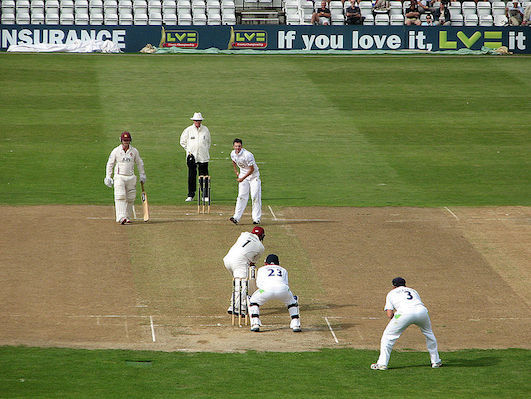Let's play cricket
 There is a hypothetical cricket match going on in kolkata between India vs Australia.
Presently there is a spinner of height 2 metre bowling first ball of the over to a right hander.He is bowling a leg stump line, his ball deceives the batsmen and he gets bowled.
There is a hypothetical cricket match going on in kolkata between India vs Australia.
Presently there is a spinner of height 2 metre bowling first ball of the over to a right hander.He is bowling a leg stump line, his ball deceives the batsmen and he gets bowled.
In the xyz,co-ordinate space consider the pitch to be the region
Consider stumps to be the lines
The ball is released from the point with a velocity m/s, also given an angular velocity of .
The question is simple, if the maximum value of , for which the batsmen can get bowled is rad/s where are integers, are co-prime, is not divisible by any square prime number then find .
Details and Assumptions
1) Assume ball a solid sphere of radius .Consider the pitch to be sufficiently rough and the collision to be elastic.
2) All the co-ordinates are given in metres.
3) If in the trajectory of the ball it is hitting the stumps, consider the batsmen bowled.
4) Consider it as a point mass while calculating it's trajectory
Image credit: Wikipedia John Sutton
The answer is 392.
This section requires Javascript.
You are seeing this because something didn't load right. We suggest you, (a) try
refreshing the page, (b) enabling javascript if it is disabled on your browser and,
finally, (c)
loading the
non-javascript version of this page
. We're sorry about the hassle.
I am assuming that you have sketched a diagram with proper parameters under proper co-ordinate axes.
Let the total distance between bowler and stumps along the x axis be D and initial velocity along x axis be v
First, We calculate the time taken by the ball to hit the ground after projection. Since it is given that ball can be considered a point object while calculating trajectory
t = g 2 h
Distance traveled along x-axis during this time is
d = v t
At this moment the ball will hit the ground and along the z-axis we will have an elastic collision and the ball will acquire a velocity of 2 g h (By energy conservation) along positive z-axis (although this information is irrelevant)
Although there is friction on the ground the relative motion between the surface of the ball and ground is along y axis due to the spin of the ball therefore the velocity along x axis will stay unaffected
Since there is sufficient friction on the ground the ground will provide an angular impulse to stop the rotation of the ball
The angular impulse provided by the ground is L = I ω where I is the moment of inertia of a sphere
The corresponding linear impulse imparted to the centre of mass of the sphere will be along y axis
P = r I ω T h e r e f o r e t h e v e l o c i t y a c q u i r e d b y t h e C O M i n y d i r e c t i o n i s M P = r m I ω = 5 2 ω r
Now we calculate the time takes by the ball to reach the stumps
D i s t a n c e R e m a i n i n g = D − d = D − v t
T = v D − d
We need to ensure that in this time duration the ball mustn't cover distance exceeding the width of the stumps along y direction
Therefore
w i d t h s t u m p s = v y × T = 5 2 ω r × v D − d
Substituting the appropriate values we get the answer.